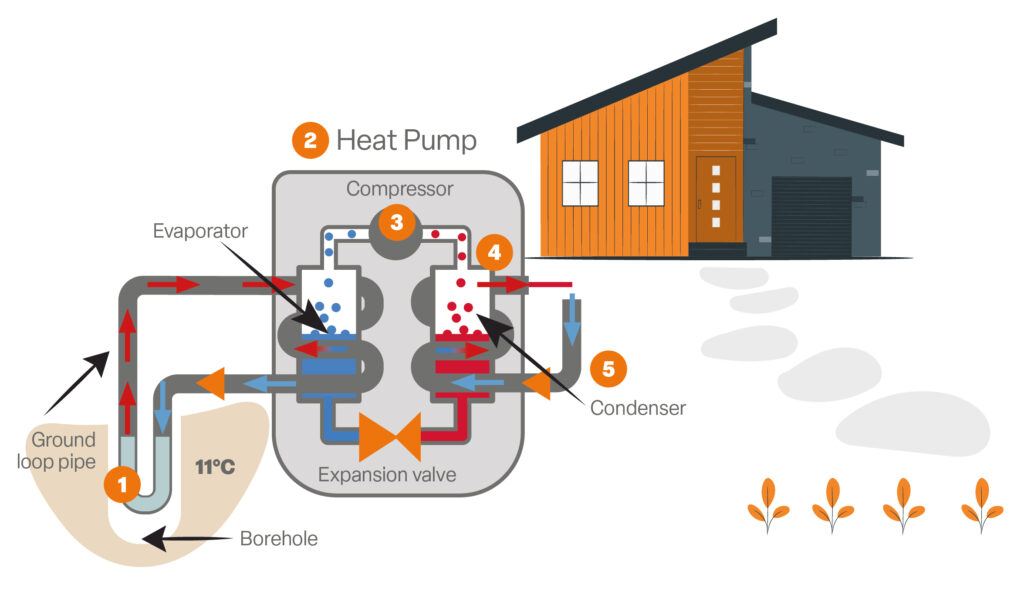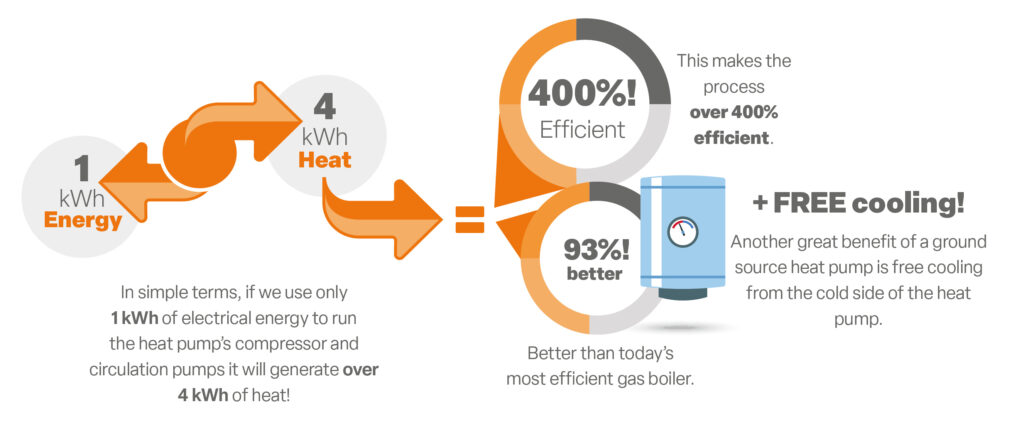Are you considering a ground source heat pump borehole for your heat pump system? Then of course you’ll want more detail about the costs involved.
We’ll guide you through a breakdown of the initial outlay of drilling a ground source heat pump borehole. Then take a brief look at the potential long-term savings a ground source system can offer.
By understanding the cost factors and benefits, you can make an informed decision about a ground source heat pump borehole and if it’s the right choice for your heating and cooling needs.
Here’s what we’ll cover or you can skip ahead to:
- Understanding ground source heat pumps and boreholes
- Factors affecting the cost of a ground source heat pump borehole
- Initial expenses of installing a ground source heat pump borehole in 2023
- What factors affect the drilling costs of a borehole for a heat pump?
- Hang on, aren’t horizontal trench systems cheaper?
- Is the price tag of a borehole for your heat pump system worth it?
- Working with your heat pump installer
Understanding ground source heat pumps and boreholes
You may be here because you’ve discovered that ground source heat pumps (GSHPs) are a sustainable and efficient way to heat and cool your home.
How do boreholes and heat pumps work together?
Boreholes and heat pumps work to extract heat from the ground and transfer it to your home through a series of pipes and a heat exchanger. Boreholes and vertical ground loops, are one of the most common types of ground source heat pump installations.
Installing a ground source heat system involves drilling deep into the ground and inserting ground loop pipes to extract heat. Understanding how GSHPs and borehole systems work will help you decide if they’re right for your heating and cooling needs.

1. How the borehole works
The borehole is deep enough to access the ambient ground temperature of approximately 11°C. The ground loop pipes carry a heat transfer fluid to the heat pump, where the fluid moves through a heat exchanger inside.
The heat pump then uses this low grade heat to evaporate a refrigerant gas, which then travels through a compressor.
From there the heat travels onto your home’s heating circuits and around your home for you to enjoy.
This in turn condenses the gas and the process starts again. There’s no combustion so the whole process emits no CO2.
Factors affecting the cost of a ground source heat pump borehole
Ground source heat pump borehole costs can vary depending on several factors. Firstly, the size of the system needed to adequately heat and cool your property. Larger systems will require more drilling and pipes, which can increase your overall drilling cost.
The depth of any boreholes is also a factor, deeper drilling will require more time and resources. Additionally, the type of soil or rock in your area can affect the cost, as certain formations may require specialised drilling equipment. Other factors that can impact the final cost include the location of your borehole(s), and site accessibility.
Initial expenses of installing a ground source heat pump borehole in 2023
In addition to the heat pump and its installation the other outlay is the ground source borehole cost. This ranges from £12,000 upwards, depending on the borehole depth and complexities of the project, and we’ll explain those next.
While these initial expenses can seem significant, a ground source heat pump borehole can provide long-term savings on energy costs, making it a worthwhile investment for many homeowners.
What factors affect the drilling costs of a borehole for a heat pump?
There’s several factors we’ll consider when calculating the cost of borehole drilling for a heat pump:
- The type of geology where you live
- How many boreholes you’ll need
- The depth we need to drill
- The width of the borehole
The geology where you live
When we calculate the price of your ground source heat pump borehole, we’ll determine the geology of your area. Ground conditions vary greatly across the UK, which influences the drilling technique, equipment and materials we use to stabilise the borehole. The geology also effects the amount of time we need to take when drilling.
How many boreholes you’ll need
Another consideration for the cost of a heat pump borehole is the amount of boreholes we need to drill. This is decided by the size of the house or area to heat. You may also need to consider the quality of your home’s insulation. Your property’s ability to retain heat will affect how much heat your system needs to generate.
As an example, heating, cooling and hot water for a well insulated 4 to 5-bedroom home may need 3 or more boreholes at 80 to 110 metres deep.
The depth we need to drill
Your final cost of a borehole for a heat pump also depends on the drilling depth. Like most drillers we charge per meter. Ground source heat pump boreholes can range from 15 to 200 meters and most are around 20cm wide.
The width of the borehole
As mentioned, most heat pump boreholes are around 20cm wide. This mainly for domestic properties commercial projects may need much wider boreholes.
Hang on, aren’t horizontal trench systems cheaper?
On the whole yes. The overall cost of a horizontal trench system can be less expensive than the cost of ground source heat pump borehole. However, there are a couple of things to consider with a trench system. A horizontal system needs much more land – fine if you have a large garden which you don’t mind digging up or live rurally.
A borehole is just a neater and space saving option. We can drill driveways, in smaller gardens and even basements! Plus, if you’re considering retro fitting a ground source heat pump system, then using boreholes means much less long-term disruption.
When considering a vertical ground source heat pump borehole cost compared to a horizontal trench system, it’s also worth mulling over reliability. Because of a borehole’s depth the heat underground is much more stable averaging around 11-12 degrees centigrade. Whereas trench system can be much more vulnerable to temperature changes on the surface.
Is the price tag of a borehole for your heat pump system worth it?
OK, a borehole is only one cost associated with your new heat pump system. You’ll need to account for the pump and any other fitting costs and equipment. As covered earlier you’ll get the best from both by ensuring your home is as well insulated as possible. If you dream of building a new green and cost efficient home investing a heat pump system is hugely beneficial. And in this case the payback time will be much quicker.
Another less known benefit of a ground source heat pump is that a byproduct is cool air! So effectively you can harness this for free cooling too!
However, many of us want to retrofit a property. With energy prices rising monthly, the reality is they aren’t going to get any cheaper. So investing now could be the key to making long term savings, not to mention helping the environment.
This is especially the case you’re currently running an inefficient gas boiler. Even the latest A-rated gas boilers should be 92% efficient, although actual performance is usually lower than this.
The initial expenses may seem daunting, however, the efficiency of a ground source system can lead to significant savings over time.
For example it only takes 1kWh to run a heat pump, in return it generates 4kWh of heat, that’s 400% efficiency! Or 93% better that a new efficient gas boiler.

Additionally, many homeowners and businesses may be eligible for government incentives that can help offset the initial expenses. In many cases, the energy savings alone can make the initial expenses well worth it.
Working with your heat pump installer
As borehole drillers, we work with heat pump companies across the UK to drill their heat pump boreholes. But, you can ask us directly to work with your chosen installation company. This can sometimes save money on your installation cost. It’s always worth getting in touch when you’re gathering your costs to find out.
We can also recommend a number of fitters, just get in touch we’re always happy to offer friendly, helpful advice.
